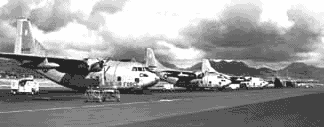
Background.
Agent Orange was not the only herbicide sprayed in Vietnam, although due to its intensified usage, it is the herbicide most commonly mentioned and blamed for health problems in connection with the Vietnam War. There were two other herbicides, an insecticide and a chemical irritant used during the Vietnam War. Each had a code name: Agent Blue, Agent Orange, Agent White, CS and Malathion.
Agent Orange (A-O) and Agent White (A-W) contain mixtures of plant hormone mimicking compounds that destroy plants by interfering with their normal metabolism. Agent Blue (A-B) destroys vegetation by preventing plants from retaining moisture.
A-O (61% usage) and A-W were effective against dicotyledonous plants (two leaves emerging from seed) and A-B (11% usage) was used for monocotyledonous plants (single leaf emerging from seed). A-W and A-O were used to destroy the forests of South Viet Nam while A-B was mainly used for the destruction of grain crops, particularly the staple crop of rice. The level of usage for military operations was 20 to 40 times greater than for normal agricultural usages. The chemicals were dispensed by fixed-wing aircraft and ground troops, a C-123 (Provider) could dump 11,000 lbs. of Agent Orange over 300 acres in four minutes.
Loss of foliage, flower and fruit occurred within two to three weeks after spraying. Not all of the trees died but a large percentage of those surviving trees were permanently damaged. Dioxin has an environmental half-life of approximately three years and has shown up in the food chain. The effect of A-O on humans has been an area of intense debate for the past two decades. It has now been established that dioxin is a very potent poison that can cause a wide range of organ and metabolic dysfunctions. In laboratory animals dioxin has shown to be Carcinogenic, Mutagenic and Teratogenic.
|
Click for larger images.
|
| 1: Unharmed forest. |
| 2: Forest after treatment with Agent Orange. |
Agent Orange caused Vietnamese farmers to lose about 70% of their crops. (One of the goals for using herbicides was to deprive the enemy of food.) 6250+ square miles of south Vietnam cannot be farmed due to defoliation. This is still true almost 30 years later.
A televised news report covering more general information, has been published on the internet. If you would like to view it, follow the link below.
MSCBC's Kari Huus explores the legacy of unexploded bombs, and Agent Orange, in central Vietnam.